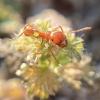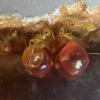Update #2
It’s been a week since I made an update, and so far the larger colony has surpassed the size of their test tube, and it has become increasingly harder to feed them. Which is why I am transferring them into a tubs and tubes setup. They’ve also gained 2 extra workers and have three to four pupae that are about to eclose, while also maintaining a decent brood pile.
The second colony, on the other hand, had a worker pass away, leaving the queen with two remaining workers and a below-average brood pile. Since their water is running low, eventually, I will have to transfer them into a new test tube soon. Although this colony has a very high appetite for its size, I’m hoping they will catch up to the other one soon.
Colony #1 (Brood is scattered around not all are visible)

Didn’t know novos did this, but they like to put their larva inside prey, and from there they eat it from the inside out. Seems interesting.

Colony #2
At the very least, they have a reasonably sized egg pile.

Sent from my iPhone using Tapatalk
























